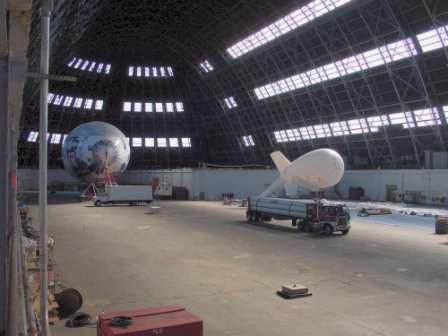Oldest military aircraft hangar in the U.S.
Location: San Antonio
Architect: Albert Kahn
Built:1917
Status: Edward H. White II Museum of Aerospace Medicine; National, State of Texas, and City of San Antonio Historic Landmark
From the above link (Brooks City-Base Fact Sheet, Air Force webpage):
Hangar 9 was constructed between 1917 and 1918 as one of twelve wood airplane hangars on the hangar line at the new Brooks Field. The curved line of twelve wood hangars and four metal hangars (now marked by Inner Circle Drive) defined the northern edge of a large dirt airfield, built without paved runways in order to allow take-offs into any wind direction. Both the site plan for Brooks Field and the original buildings were designed by the office of Detroit, Michigan architect Albert Kahn. Kahn was a German-born architect who supplied standardized plans for a number of U.S. Army Air Corps installations, including Langley Field in Virginia and Arcadia Field in California. Kahn later achieved fame as the designer of numerous industrial facilities worldwide, including the Ford Model-T factory in Detroit, Michigan (1909), the Goodyear Airdock dirigible hangar in Akron, Ohio (1929), and the Dodge Half-Ton Truck Plant in Detroit, Michigan (1938). Kahn’s industrial designs are characterized by the use of complex truss systems to span vast spaces, as well as the adaptation of modular architecture to production processes.
Although little is known of the historic uses specific to each of the sixteen hangars, Hangar 9 would have been an essential part of all flight training programs at Brooks Field, from the Primary Flight School of the World War I period to the Advanced Flying School of the 1940s. Historic photos show phalanxes of Curtiss Jennys lined up outside each hangar on the line, pointed south in preparation for takeoff. Later photos show that the ‘temporary’ wood hangars were still housing BC-1 aircraft in the 1940s.
With the end of pilot training at Brooks came neglect for the delicate wooden hangars. In 1962, two years after the last flight departed from Brooks AFB, Hangar 14 caught fire and burned, leading the base commander to call for the demolition of all the remaining wooden hangars as possible fire hazards.
The intervention of the Order of Daedalians aviators’ group, Representative Henry B. Gonzalez, and local historical societies caused Secretary of the Air Force Harry Brown to consent to the salvation of Hangar 9.
In 1968, the Bexar County Historical Survey Committee assumed sponsorship of the restoration of the dilapidated hangar, which would be used to house an aviation museum. Today, Hangar 9 houses the Edward H. White II Museum of Aerospace Medicine. It was listed in the National Register of Historic Places in 1970 and was designated a National Historic Landmark in 1976. Hangar 9 is also a Recorded Texas Historic Landmark, and a City of San Antonio Historic Landmark.
Author’s note: It never ceases to amaze how buildings, aircraft, and other items that will come to be venerated almost always must avoid some intent to tear them down or otherwise dispose of them once their original use has passed.
More info and photos at this National Park Service page: http://www.cr.nps.gov/nr/travel/aviation/bro.htm






